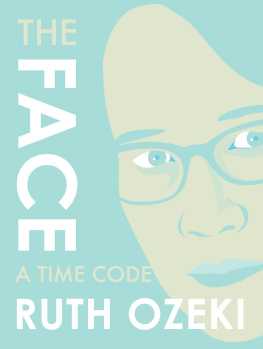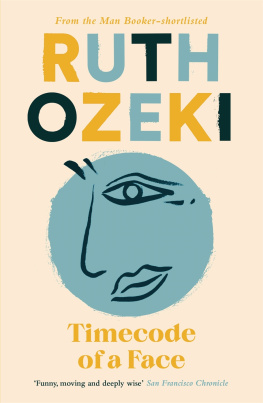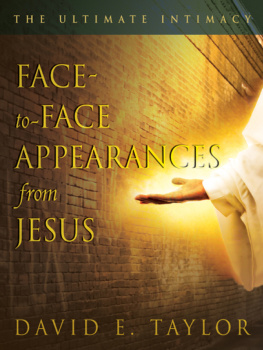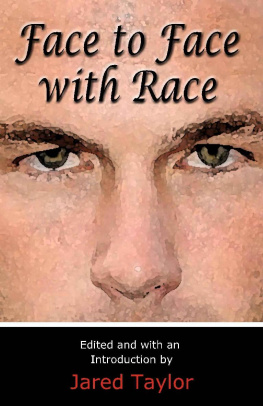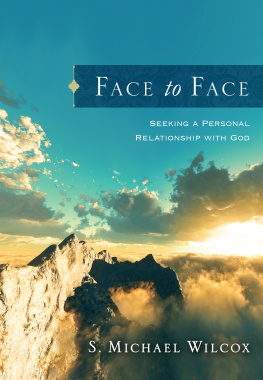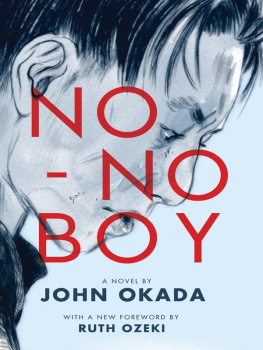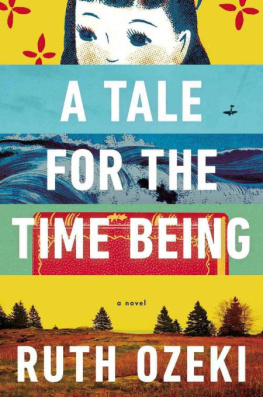The Face: A Time Code
Ruth Ozeki
Restless Books | Brooklyn, NY

The Face: A Tim e Code
Prologue: a Koan
What did your face look like before your parents were born?
I first read this koan when I was eight or maybe nine years old. Someone had given me a little book called Zen Buddhism or perhaps the book had belonged to my parents and Id taken it from their shelves, thinking it ought to be mine. The book was small and slim, the perfect size for a child to hold, but more importantly, it had a friendly face, which made it stand out from the other duller books on my parents shelves. A books face is its cover, and this one, with its simple flowers against a muted orange background, appealed to me. A solid black box in the upper right corner contained the title: ZEN . The letters were tall and hand-drawn, in a floaty, white, Art Nouveau font that looked like ghosts, dancing. Beneath, in very small caps, was the word BUDDHISM .
Inside the cover was the subtitle: An Introduction to Zen with Stories, Parables and Koan Riddles of the Zen Masters, decorated with figures from old Chinese ink-paintings an exceedingly long subtitle for such a small book. It was published in 1959 by Peter Pauper Press, and I know this because I did an online image search for Zen Buddhism small orange book, and there it was, a familiar face, instantly recognizable, looking out at me from my computer screen after more than five decades.
The little book was a talisman, a teacher, a gate. It was filled with gnomic tales of old Zen masters posing paradoxical questions that confounded my nine-year-old notions of rational narrative in a way I found both fascinating and perplexing, and so I assumed they must be profound and very wise.
What is the sound of one hand clapping?
How can one catch hold of Emptiness?
Does a dog have buddha nature?
When there is neither I nor you, who is it who seeks the Way?
Listed like this, these koans might sound clichd, but they were brand new to me. The crazy old Zen masters, with their staffs and whisks and comic antics, who were always slapping and cuffing each other, cutting off their arms and eyelids, and pulling each others ears and noses, seemed to hold a key to my nine-year-old identity.
What is your original face?
I read the koans earnestly, searching for an answer.
Time Code 00:00:00
00:00:00 Ive put the mirror on the altar where the Buddha used to be. Laptops just below it. Fussing now with the seating, arranging the cushions. How close should I be? How much proximity can I tolerate? How is the lighting? Flattering? Unflattering? Does it matter? Should I change into a turtleneck to hide the lines on my neck? Hide them from whom? Is the neck even part of the face, and do I need to wash my hair? Do I need reading glasses, or can I type without them? Can I see without them? No, no glasses. No need to look at the computer screen. Just face and me, facing off in the mirror.
00:04:14 Okay. Ready. No, wait, theres dust on the mirror. Must clean it. Do I have vinegar? Yes, under the sink.
00:07:26 Mirrors spotless.
00:08:56 How do I start?
The Experiment
The experiment is simple: to sit in front of a mirror and watch my face for three hours. Its a variation of an observation experiment I came across in The Power of Patience, an essay about the pedagogical benefits of immersive attention by Jennifer L. Roberts, a professor of art history and architecture at Harvard. In her essay, Professor Roberts describes an assignment she gives her students each year: to go to a museum or gallery and spend three full hours observing a single work of art and making a detailed record of the observations, questions, and speculations that arise over that time. The three-hour assignment, she admits, is designed to feel excessively long. Painfully is the word she uses, asserting that anything less painful will not yield the benefits of the immersive attention that she seeks to teach. Paintings are time batteries, she writes, quoting art historian David Joselit. They are exorbitant stockpiles of temporal experience and information that can only be tapped and unpacked using the skills of slow processing and strategic patienceskills that our impatient world has caused to atrophy. Shes trying to help her students develop their stunted skill set so they will learn not simply to look at art, but to see it.
My face is not a work of art. There is no reason for me to look at it other than to make sure theres no spinach stuck between my teeth. I rarely put on makeup. My hair seems to take care of itself, more or less. But after reading Robertss article, it occurred to me that a face is a time battery, too, a stockpile of experience, and I began to wonder what my fifty-nine-year-old face might reveal if I could bear to look at it for three hoursa painfully long time, indeed.
My relationship with my reflection has changed over the years. As a young child, I was indifferent to my reflected self. As I grew a bit older, I turned shy and avoided my reflection, but by the time I was a teenager, I was spending lavish amounts of time in front of mirrors, scrutinizing every follicle and pore, and developing a minute and almost microscopic relationship with my surfaces. I dont think I was different from most American teenagers in this way. The compulsive self-regard continued into the early years of my adulthood and then diminished as I aged. Now, although I still check my reflection in shop windows and glance at my face when Im washing my hands or brushing my teeth, I spend very little time in front of mirrors. And yet, over a lifetime it adds up towhat? Hundreds of hours? Days or weeks or months even?
Three more hours should be doable, but Im loath to start. Why? Is it vanity? Anti-vanity? How would I know? What does fifty-nine-year-old vanity look like, anyway? Fifty-nine is a difficult age for a face. Menopause wreaks havoc with a faces sense of self, and the changes are rapid and cascading. Its like puberty in reverse. At fifty-nine, I never quite know what my face will be when I wake up in the morning.
Mirror, mirror on the wall, whos the fairest of them all? mutters the aging queen.
Our tales all tell us that an old womans vanity is, at best, sad and unseemly, and, at worst, ridiculous or even evil. As I approach my sixtieth year, I feel I should be moving away from the question Am I still fair? toward a more existential question: Am I still here? Youd think seeing myself in a mirror would be somewhat reassuring.
And yet, recently Ive noticed that when I catch sight of my face in a shop window, Im quick to look away. When I brush my teeth, Ill often turn my back to the mirror, or focus on a detail of my reflection, a blemish or a spot, rather than on my aspect as a whole. Its not that I dont like what I see, although thats often part of it. Rather, its more that I dont quite recognize myself in my reflection anymore, and so Im always startled. Averting my gaze is a reflexive reaction, a kind of uncanny valley response to the sight of this person who is no longer quite me.
Its not polite to stare at strangers.
In Zen teachings, impermanence is the first of the three marks of existence. Everything changes, nothing stays the same. The second mark of existence is no-self , which derives from the first: if everything changes and nothing stays the same, then there is no such thing as a fixed self. The self is only a passing notion, a changing story, relative to its momentary position in space and time. Suffering , the third mark of existence, derives quite logically from the first two. We dont like impermanence, we want to be someone, a fixed self, and we want that self to last. Lacking that fixity, we suffer.

